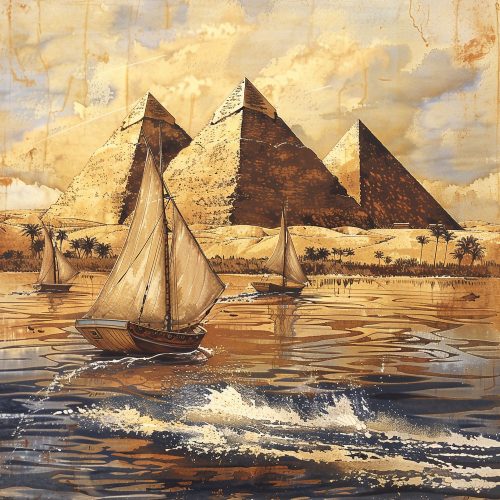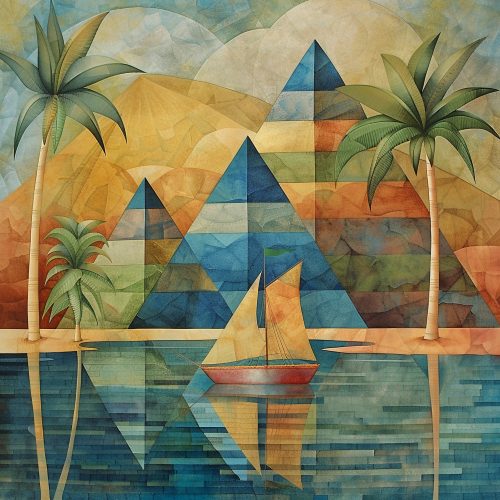
The history of Egyptian glass dates back over 3,500 years, and Egypt was one of the first places on earth to master the art of crafting delicate and beautiful glass objects from raw materials.
Beads and amulets found in burial sites provide the earliest proof of glass manufacture. These glass artefacts were primarily used for ornamental and symbolic purposes, frequently accompanying the departed souls into the afterlife.
Glass was reserved for high-status individuals, as the skill of glassmaking was still quite rare, found only sparingly in Egypt and Mesopotamia.
In the Old and Middle Kingdoms, as well as beads and amulets, coloured glass was used to make mosaics, jewellery, inlaid furniture, and figurines. At this time, the skills of the Egyptian glassmakers were still quite basic.
Highly skilled glassmaking in Egypt took root in the 18th Dynasty (1550–1292 BC). This was the time when Tutankhamun was on the throne of Egypt (1341 – 1323 BC), although his reign coincided with the latter part of the 18th Dynasty.
The 18th Dynasty was the first Dynasty of the New Kingdom and was the era when Egypt reached the peak of its power.
At the beginning of the New Kingdom, workshops were to be found in many towns, including Armana, Malkat, Lisht, and Pi-Ramesses.
In 1892, when renowned British Egyptologist Flinders Petrie was joined by fellow British Egyptologist Howard Carter, their pairing coincided with the discovery of ‘amulet factories’ at Amarna, where faience (the raw, precursor to Egyptian glass) was produced and other glass and glaze workshops were found nearby by local children. The pair would later go on to discover the Tomb of Tutankhamun.
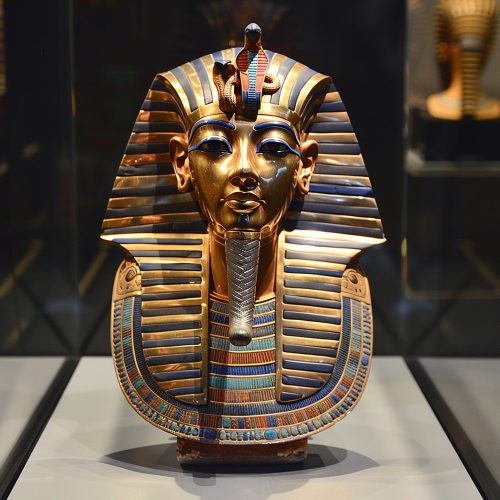
You can find out more about the glass in the Tomb of Tutankhamun here:

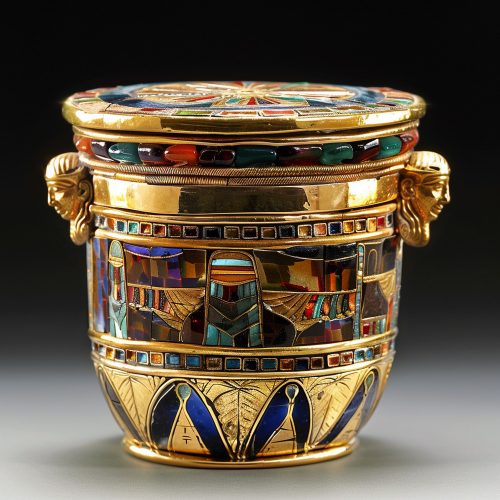
Egyptian Glass Vessels
The first recording of pure glass vessels being made was during the reign of Thutmose I (1506–1493 BC) in the New Kingdom. Glass vessels were made to hold perfumes and oils, and the glass was combined with metals to create objects of great beauty for high-status individuals.
Metal tools were used to create patterns such as combed glass, zig-zags or fish scales.
The new glassmaking skills were probably imported from the Middle East, where the Egyptian pharaohs had been expanding. Full-scale glass making began in Egypt by Middle Eastern glass makers captured by Thutmose II (1479-1425 BC) and brought back to Egypt as slaves.
Glass objects embodied grandeur and luxury. High-end jewellery made of glass also demonstrates the Egyptians’ great sense of style and ornamentation. The aristocracy wore intricate gold and glass pendants, highlighting the importance of glassmaking to culture and the economy.
Colourful amulets were made by combining metal, semi-precious stones, and glass, and figurines were meticulously carved to add details such as clothing and hair.
How Egyptian Glass Was Made
Locally obtained raw materials were combined to make faience, the precursor to glass. A small cylindrical ceramic vessel was used as a crucible. The raw materials included an alkali (Natron – sodium carbonate), which is found in dry river beds or made by burning sea plants from salt marshes and was used as a flux to lower the melting point and make the glass more pliable. Potash (potassium carbonate) is another flux alkali made from burning wood that was used in inland areas where there were no salt marshes. Human and animal bones were sometimes crushed to provide the calcium carbonate used in the glazes as a flux and to provide hardness. Egg shells and sea shells were also used as sources of calcium carbonate.
Silica was obtained either from the desert sand itself (which is often rich in quartz) or from crushed quartz pebbles. Lime was naturally found in the Natron and quartz, and the sand was naturally rich with lime at Amarna. The mixture of silica, Natron and lime was heated up to 750 degrees Celsius in the kiln until it became a molten ball. This was the ancient equivalent of the ‘fritting’ process, and the material produced was called faience. By doing this, most of the trapped bubbles escaped from the raw material used. Once cooled, it was crushed up and mixed with a colouring agent.
The ancient towns made their glass unique by colouring it. In Amarna, they added cobalt to make their glass blue, and in Pi-Ramesses they added copper to make the glass red. Red glass was very hard to produce as it had to be fired without oxygen. If oxygen got in, it would oxidise it and turn the glass blue.
Once the towns had added their colouring agent, the faience would be funnelled into another cylindrical ceramic vessel and heated a second time to a higher temperature. It was made of clay, and the inside was coated with a layer of lime to stop the iron-rich Nile clay from discolouring the glass ingots. Once the glass had cooled, the cylinder was broken to reveal the glass ingots. Going through these two stages had a number of advantages. It got rid of the majority of bubbles, reduced the melting point, and improved the quality of the end product in the same way that reusing waste glass cullet does.
These coloured cylindrical ingots of glass were then sent to smaller workshops, where the faience was covered in glaze and fashioned into beads, animal figures, and other glass objects.
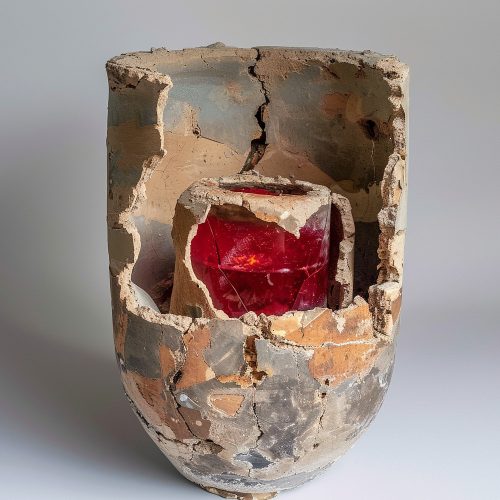

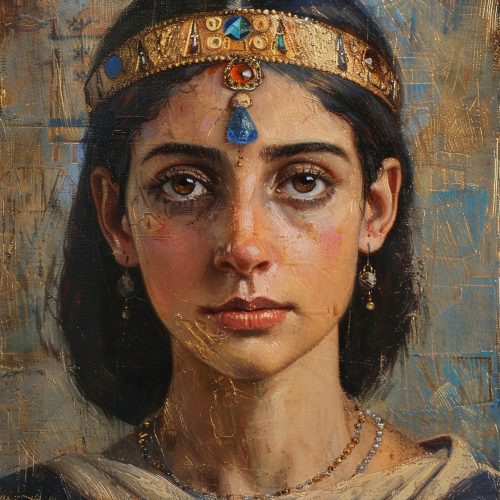
Some ingots even made it across the sea to Mycenae on the north-eastern Peloponnese peninsula of Greece, where they were fashioned into locally styled glass objects.
As glass was still very easy to break, it was easier to send out the glass in ingots, and then local glass workers could fashion the glass into what was required.
Many Egyptian glass ingots have been found in shipwrecks across the Mediterranean, showing that glass was an important trading commodity for the Pharaohs.
The influence of ancient Egyptian glassmaking on adjacent civilizations expanded along with its unparalleled artistry. The Egyptians became expert traders, sending their glass goods to countries in the Middle East, the Mediterranean, and beyond. The demand for Egyptian glass skyrocketed, and the glass industry of other ancient societies flourished because of the skills pioneered in the Nile Valley.
In ancient texts, offerings made at temples were gold and silver, followed by glass and lapis lazuli. Showing the importance given to glass as a luxury item at the time.
In the Amarna Letters, which detailed the demands for gifts from vassal princes from what is now Syria and Israel, the most commonly asked for gifts were glass objects.
Core Forming
The method of making larger objects was known as core-forming, where a clay mould was wrapped in canes of molten glass and heated each time to fuse the previous tube of glass to the next tube. Once the glass wrapping was finished, the outer glass was polished, and the clay mould was gently crushed and scraped out, leaving just the highly polished glass behind.
They used the same process to create jars, cups, bowls, and bottles.
Over time, the skills of the Egyptian glassmakers became well honed. The discovery of the renowned “Fayum portraits,” which are lifelike images on wooden panels set atop mummies during the Roman era, is one noteworthy instance. The superb glass inlays on a few of these images demonstrate the Egyptians’ skill at fusing various materials to produce art that is both aesthetically pleasing and long-lasting.
Additionally, glass was used in the construction of gigantic structures. Translucent glass windows allowed sunshine to stream into the interiors of several temples and palaces. The Egyptians’ inventive approach to architecture and their aim to create visually beautiful places were demonstrated by this architectural usage of glass.
The golden age of ancient Egyptian glassmaking eventually came to an end, despite its incredible accomplishments. The invasion of foreign powers and political upheavals that upset the region’s cultural and economic stability are frequently blamed for its downfall. The decline in popularity of Egyptian glassmaking was attributed to the loss of knowledgeable craftspeople and the dispersion of expertise.
Egyptian glass production greatly declined after the 21st Dynasty (1096–945 BC). It was revived, but on a much smaller scale, during the 26th Dynasty (664-525 BC).
It was overtaken by other powers, most notably by the Romans, who continued to evolve the art of glassmaking.
Further Reading
Studies in early Egyptian glass by Christine Lilyquist, Robert H. Brill and M. T. Wypyski – 